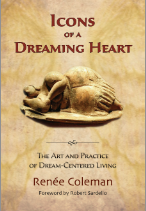In our continuing series of Starting Places and Radical Givens of Dream-Centered Living, we want to highlight that Everything Belongs and Is Connected (just as we are). We might say that this is the premiere starting place of Dream-Centered Living, for without this as our faithful, unwavering orientation toward dreams and tending them, everything else crumbles. This includes tending the dream of our lives, in other words, the dream each of us is in at every moment, whether we are awake or sleeping or somewhere in between.
It may take a considerable leap of faith to accept that absolutely everything belongs, especially in the beginning of working this way. For we are generally more inclined to overlook what seems insignificant to us, or incidental, or to skip over those aspects of the dream that we find unpleasant or difficult to look at, too dark, or as blatantly untrue, too wild, preposterous, crazy, unwanted, or just plain weird. And how often do we completely dismiss those dreams that strike us as “old hat,” as something we imagine we already know? But the dreamtime does not work this way. Ever.
When we dismiss dream contents as insignificant, or dismiss dreams altogether, it simply highlights that we’ve once again put ourselves before the dream, falsely imagining that dreams are somehow “about us.” It’s easy to see why we do this– especially during those epic-like narratives, the King-Kong-On-Ice variety of dreams—when we play starring roles in the unfolding dream action. Now, it’s not that dreams are not about us. They are. But they’re not only about us. For one thing, there’s no such thing. We are not separate objects in space bumping up against other objects in space, even if it sometimes feels that way. We would be wise, therefore, to remember that the seemingly central roles we play in the action of dreams is more or less a trick of the dreamtime—a spiritual-soul sleight of hand to keep us interested and engaged with dreams and dreaming at all.
The task of Dream-Centered Living, therefore, is to notice as much as we possibly can of the dream contents and of dreaming itself, and especially with regard to what the dream is doing, while at the same time gently prying ourselves out of falsely imagining that we know anything in advance of it being revealed to us in the context of the whole dream. Another way of saying this is that everything belongs. So the practice for us involves looking around for what we don’t know, for what we’ve not previously seen or experienced. This is especially true in the case of recurring dreams.
Eventually, with patience and practice, the belonging and connectedness of things will be experienced as utterly invitational, allowing us to become ever more relational with all that is present and being asked of us.
I find it helpful to imagine dreams as extended family members. So, for example, while I may well wonder how my favorite cousin ended up with so-and-so, a person that I’m not particularly fond of or keen on or that I find difficult to admire, and certainly not someone that I would have chosen for my favorite cousin were it up to me, it doesn’t change the simple fact that my cousin and so-and so are, indeed, together, a couple.
In other words, we want to get curious regarding how the various dream images are related, how they belong together in the same dream. And this is not something that we can ever “understand,” at least not in a making-sense-of-things sort of way.
In order to do this we are required to notice our reactions to things, for our reactions too belong. We want to work towards acknowledging that whatever is actually present has a place, that it somehow belongs. But, and this is important, at the same time we want to find ways of not allowing ourselves to become distracted by, or taken over by, our reactions, as if our reactions to things are somehow more important than everything else that is also present. In other words, we want to learn how to not let what we feel “about” things to split off and do business on its own. This takes considerable effort on our part, for we have been led to believe that our reactions to things are somehow king, that our likes and dislikes, for example, define who we are and are what make us unique and special.
But what we discover when we work this way is that it does not matter one iota whether we like the particular dreams we are working with or, or whether we are frightened by them, or confused, or confounded even. The task is to stay present in a turned-out-sort-of-way and noticing, without judgment, all that we can. So even if we don’t “feel” as though we can relate to a particular dream, we want to take it on faith that we are already related. In time we learn that our reactions to dreams, like the contents of dreams, are merely secondary to the activity of dreams, or what the dream is doing, and how it seeks to be engaged with on its terms rather than merely our own.




Beautifully opened up and written … Everything is related … Yes! Take it on faith … Yes!
Yes! Take it on faith until you know it directly.